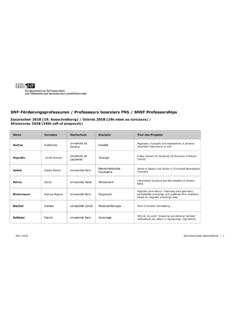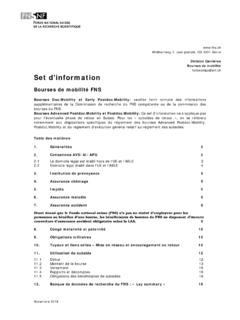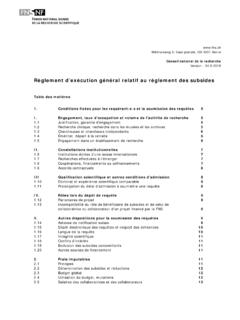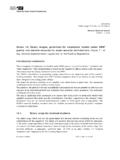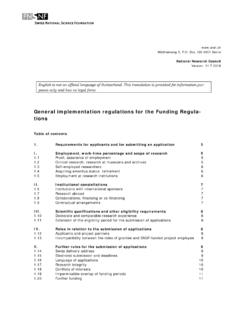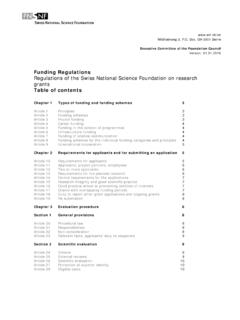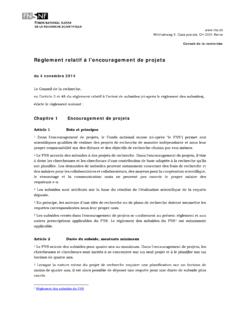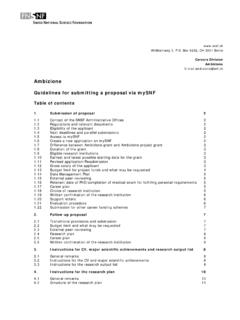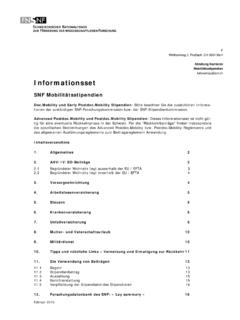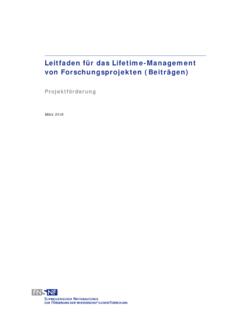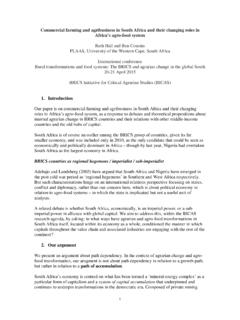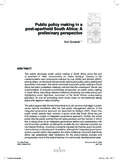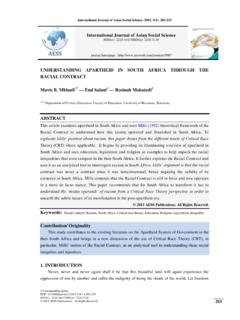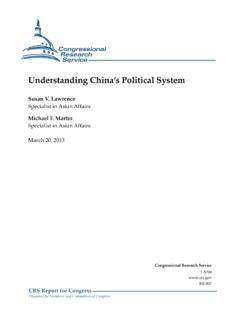Transcription of Economic Sanctions against South Africa and the …
1 3, Postfach 8232, CH-3001 BernAbteilung ProgrammeNationale Forschungsprogramme Research summary PNR42+ Economic Sanctions against South Africa and the Importance of Switzerland Ch. Hefti, E. Staehelin-Witt In 1986 about 40 years after the beginning of Apartheid South Africa s most important trad-ing partners (the USA, the EC, and Japan) imposed Economic Sanctions . During the course of the 1985 debt crisis, the time seemed to have arrived to finally force the Apartheid regime to its knees by Economic Sanctions . Switzerland did not abide by the Sanctions . The study examines if the fact that Switzerland did not take part in official Economic Sanctions delayed the political transformation of South Africa . Economic Sanctions against South Africa Sanctions imposed The Economic Sanctions covered trade and finance.
2 In the trade sector, the EC and Japan sanc-tioned import of the Kruger rand and certain steel and iron products, whereby Germany and Great Britain in part merely made recommendations and imposed no binding Sanctions . The USA too embargoed importing the Kruger rand and certain steel and iron products. The Sanctions also covered import of products from partially state-controlled enterprises, uranium, coal, textiles, agricultural products, and food as well as export of petroleum products. The most crucial trade sanction was OPEC s oil embargo, though it also had loopholes. One must distinguish between direct, portfolio, and other investments (credits/loans) in regard to financial Sanctions . Foreign direct investments were defined by their goal: establishing a long-term relationship with the target firm abroad and assuring an important influence on business.
3 If the shares held exceed 10%, investments qualified as FDI. Those below 10% count as portfolio investments. Other investments included credits in particular. The EC sanctioned new direct investments but left it to member states to declare if the Sanctions would be binding. The two major investors (England and Germany) failed to impose binding Sanctions . The USA also sanc-tioned new direct investments and was the only country to impose Sanctions on portfolio invest-ments and credits/loans. In general, Sanctions imposed against South Africa were very limited and indicate numerous loopholes and exception clauses. One reason for the limitation surely lay in the fact that the heads of government in Britain, the USA, and Germany did not regard Sanctions as the correct means of prompting political change in South Africa .
4 Since the constructive engagement ap-proach favored by them (stabilizing South Africa , which would strengthen the will of South Africa Schweizerischer Nationalfonds | 2 to reform) but did not lead to ending Apartheid for many years, advocates of Sanctions could ul-timately prevail. The economists public-choice theory argued for this reason that Economic Sanctions often have so minimal an impact because they are selected primarily to suit the Economic interests of the sanctioning countries and only secondarily consider the costs on the country sanctioned. In the case of South Africa , the choice of sanction sectors confirmed this thesis. In the USA, for in-stance, there were interest groups that profited from Sanctions on South African coal and food. Accordingly, these sectors were sanctioned by the USA, but not by the EC or Japan.
5 For its part, the EC sanctioned steel. Since this was one of the EC s most highly protected sectors, Sanctions helped European producers get rid of one of their strongest competitors at the same time. Switzerland s position Switzerland maintained its basic stance of rejecting Sanctions in the case of South Africa as well. The 1986 position of the Federal Council stated that it disapproved of Economic measures to achieve political goals. Nevertheless, politics also intervened in Economic ties. A ban on public loans to South Africa was enacted in 1978. From 1974 on, the government set a ceiling on cer-tain capital exports requiring licenses. During the course of other countries Economic Sanctions , statistical monitoring also took place from 1986 on. In addition to monitoring capital exports, it covered all sectors in which the most important industrialized countries enacted congruent eco-nomic Sanctions .
6 Sectors were also statistically monitored in which converging Sanctions had not been imposed or were at least subject to heated dispute ( , direct investments). These measures were intended to have prevented Third States from circumventing Sanctions through Switzerland. Costs of trade and financial Sanctions imposed on South Africa Capital outflow and its causes During the Sanctions period (4th quarter 1986 1st quarter 1991) South Africa suffered a net capital outflow of billion rands, which corresponded to an annual average of 2% of GNP. However, the net outflow of foreign investment had already begun before introduction of the Sanctions . South Africa suffered its greatest net capital outflow, which led to the moratorium on debt, in 1985, one year before imposition of Economic Sanctions .
7 Schweizerischer Nationalfonds | 3 Illustration 1: Net capital flow in % of GSP -6% -4% -2% 0% 2% 4% 6% 8% 1956 1958 1960 1962 1964 1966 1968 1970 1972 1974 1976 1978 1980 1982 1984 1986 1988 1990 1992 in % of GPS Source: South Africa s balance of payments 1946-2000, South Africa s national accounts 1946-1998 The massive outflows of capital could be traced to three factors in particular: Political unrest Already in the past the Sharpeville massacre of 1960 and the Soweto unrest of 1976 had led to far-reaching and long-term outflow of capital (see Illustration 1). The political un-rest that led to the National State of Emergency (20 July 1985: Partial State of Emergen-cy; 12 June 1986: National State of Emergency), was traceable on one hand to the struggle of the domestic anti-Apartheid movement; on the other hand, there was also un-rest between competing black groups.
8 The unrest reduced investor confidence in the country s future. The poor Economic situation South Africa found itself in a recession between 1984 and 1985, and even after 1986 the GNP increased less than the population. An important cause for Economic weakness was Economic policy, which was closely linked to Apartheid ideology. South Africa had high and increasing government outlays based on high defense costs among other factors. It pursued Economic self-sufficiency, yet this limited South Africa s long-term competitive-ness and thus stemmed the flow of foreign investment as well. The country also had to cope with high inflation, scarce currency reserves, and mounting short-term debt. Pressure from the anti-Apartheid movement Foreign and South African anti-Apartheid groups demanded an end to business ties with South Africa and withdrawal of firms active in the country.
9 The American anti-Apartheid movement had the greatest success. A few American states and cities exerted strong eco-nomic pressure on the firms, which resulted in their withdrawal. However, the overall impact of disinvestment on the balance of payments was comparatively minor. It was ra-ther small and unprofitable firms that withdrew from the market. Moreover, there were unintended profiteers. Particularly the large South African conglomerates benefited from American and British sales, since they could acquire divisions of firms at favorable pric-es. Sharpeville Soweto State of Emergency Sanctions Start of unrest Schweizerischer Nationalfonds | 4 The costs of financial Sanctions Officially imposed financial Sanctions had comparatively little impact on capital outflow. Or, as the president of the South African central bank, De Kock, put it in 1986: The EEC and US sanc-tions packages on bank loans and investments do little more than change a de facto into a de jure situation.
10 From South Africa s vantage point, financial Sanctions hardly prevented flow of capital that would have been transacted without Sanctions . This had several reasons. The EC and USA sanctioned new direct investments, though the EC s two largest investors, Germany and Great Britain, only enacted voluntary Sanctions . Yet, due to the poor Economic situation at the time, new direct investments were hardly transacted anyway. More crucial was reinvestment of profits, and this most important possibility of FDI was exempt-ed from the Sanctions . More than 80% of all FDI in South Africa during that period originated from reinvested profits. The existence of reinvested profits also increased during the Sanctions era by about 3 billion rands. This showed that the investors had maintained a certain trust in South Africa and also expected no sharpening of Sanctions .
